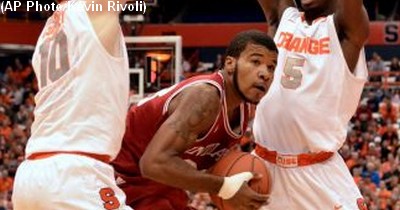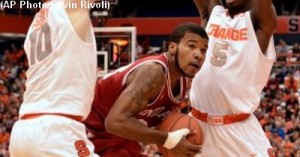
At risk of inflaming Syracuse fans, this column will start with what can be taken as a crack at their schedule. Here it is:
It is not very often that the Orange reach the midpoint of December with the perfect symmetry of an equal number of power conference foes and non-power conference foes on the schedule.
Can we skip the responses about how almost every high-major team schedules the same way and the like and instead get to the point? Thank you.

Since this season has met a point with five teams per side of the “power” opponent/”non-power” opponent equation, let’s take a brief look at some of the numbers SU has compiled thus far to see if we can parse anything of note before they set sail on the meat grinder portion of the schedule known as Villanova and the Atlantic Coast Conference. Obviously, there is volatility associated with the small sample sizes and possibly grains of salt abound, but there are likely trends, both good and bad, that may suggest additional facts about the Orange.
(For purposes of this column, Minnesota, California, Baylor, Indiana, and St. John’s will be referred to as the “power” foes and Cornell, Fordham, Colgate, St. Francis (Brooklyn), and Binghamton will be referred to as the “non-power” opponents. Similar terms will also be used to differentiate.)
» Related: Syracuse is still New York’s College Team after win over St. John’s
On the season, the Orange currently own a +13.8 point differential on the season and when split into the two groups, there probably is not anything particularly intriguing from a comparison standpoint, as SU is sporting a +18.0 differential against the “non-power” schools and a +9.6 mark against the “power” opponents. In fact, the only thing of note is that Syracuse is beating similar sized programs by nearly double digits on average. That bodes well over the long-term.
SU’s offense has done about equally well against both groups, averaging 2.2 points a game and making two more field goals against the smaller schools (135 to 133), although needing 48 more shots to do so. When you factor in Jim Boeheim shortening his bench against “power opponents” (only cameos from freshmen other than Tyler Ennis and minimal appearances by walk-ons in these contests), it certainly appears that the rotation players who will soak up almost all of the minutes the rest of the season have no problem scoring.
A factor in that field goal shooting being better against the big boys is the Orange simply have not shot as many three-pointers against them. Syracuse has tried 42 more triples against “non-power” opponents and only made 11 of them. The numbers against “power” opponents? SU is 23-of-60 from deep, good for a 38.3 percent success ratio.
Again, the freshmen outside the rotation and walk-ons are culprits here. Their collective 3-for-31 “marksmanship” over the entire season hurts the team averages, but they are not likely to have much effect during conference play. In fact, when you exclude those players, the Orange players currently in Boeheim’s rotation are hitting 54-of-131 (41.2 percent) from beyond the arc on the season.
The three-point defense has been better against the big schools, too. Syracuse has seen small conference opponents, who probably aim to shoot more threes by design (they are averaging over six more tries from deep per game against SU than the “power” teams) to make up for deficiencies in athleticism and size, hit 35.2 percent of their threes, but the big schools make under 32 percent from beyond the arc. Not too shabby.
Unfortunately, the other side of that coin is the Orange defense against two-point field goals. SU has been worked over by “power” teams inside the arc, allowing them to make just under half their tries in that area. By comparison, the smaller schools have made 45 percent of their two-point tries.
An even bigger concern raises its head in rebounding. While commentators frequently speak to the height and length of the Orange as great attributes, and they certainly are, SU has rebounding issues.
While acknowledging that playing a 2-3 zone defense makes it more difficult for teams to rebound because there is not an assigned man for each player to block out, Syracuse has pulled down 16 fewer boards than their “power” opponents this season. In fact, the best finish the Orange have on the boards against any of those foes in a single game is simply breaking even.
» Related: What we learned from Syracuse’s win over St. John’s
In contrast, SU has bullied small schools on their schedule, grabbing 64 more rebounds in those five games than their opponents. Between the discrepancies in rebounding and two-point field goal defense, it seems the Orange certainly have some things to work on that fall under “attention to detail.”
On an individual player basis, only one person on the Orange roster showed anything more than a minor statistical difference along the “power” and “non-power” opponent lines. It’s Tyler Ennis, freshman point guard, and I use the phrase “freshman point guard” because his stats are just about the opposite you would expect from any normal player at the position with that experience level.
While Ennis has garnered about 40 percent more minutes against “power” conference opponents thus far, his statistics exceed and crude mathematical adjustment based on court time alone:
Against “power” opponents:
- 17.8 points and 6.4 assists per game, 6.4-to-1 assist-to-turnover ratio
Against “non-power” opponents:
- 6.8 points and 3.6 assists per game, 3.0-to-1 assist-to-turnover ratio
Again, Ennis does log more time against the better opponents, and that certainly adds a little bit of padding to his line on the stat sheet, but he is simply turning in great play against them. While those gaudy numbers may erode, especially as the season wears on and the high level of competition in the ACC shows up game after game, there is just another thing to like about Ennis thus far.
For more Syracuse coverage, Like our Facebook page and follow us @TheJuiceOnline.

